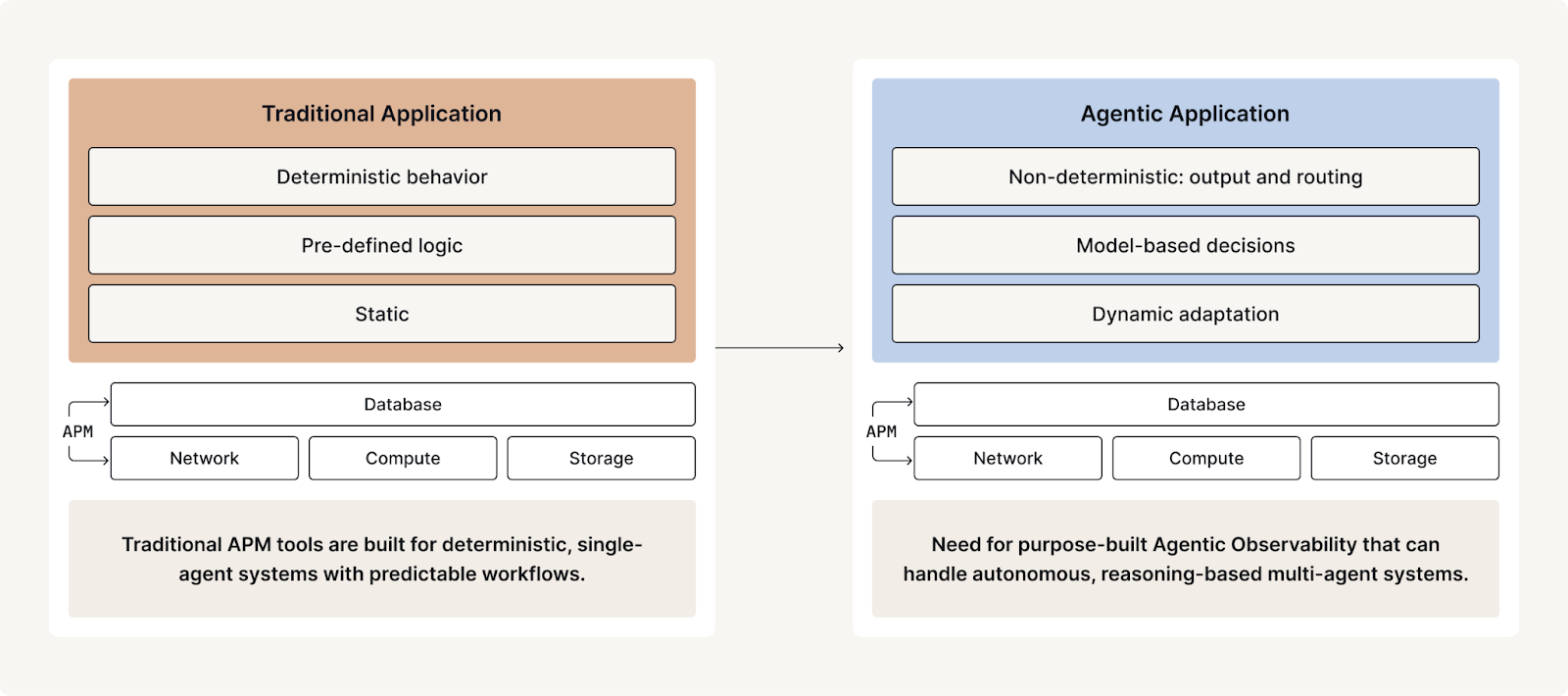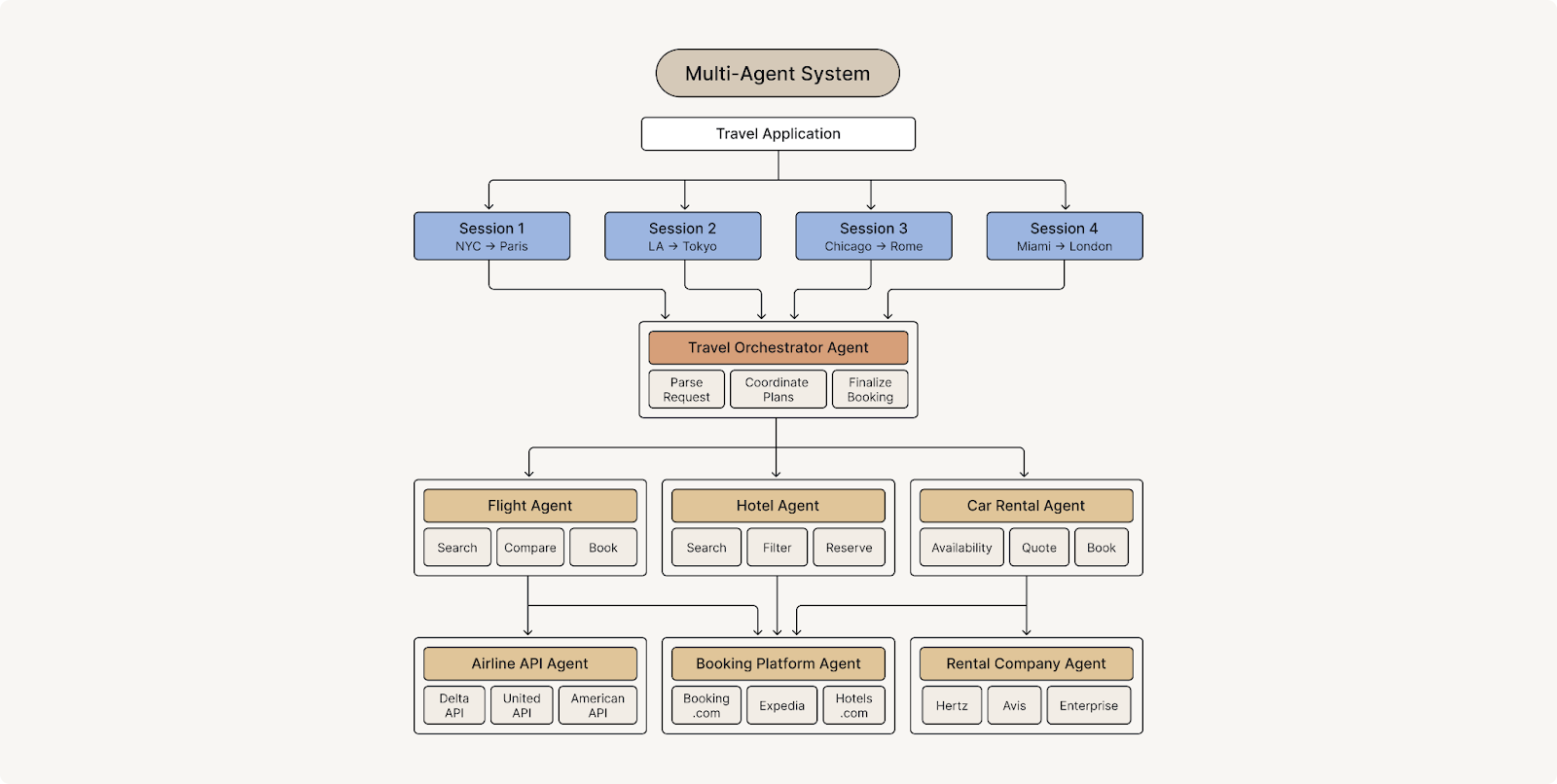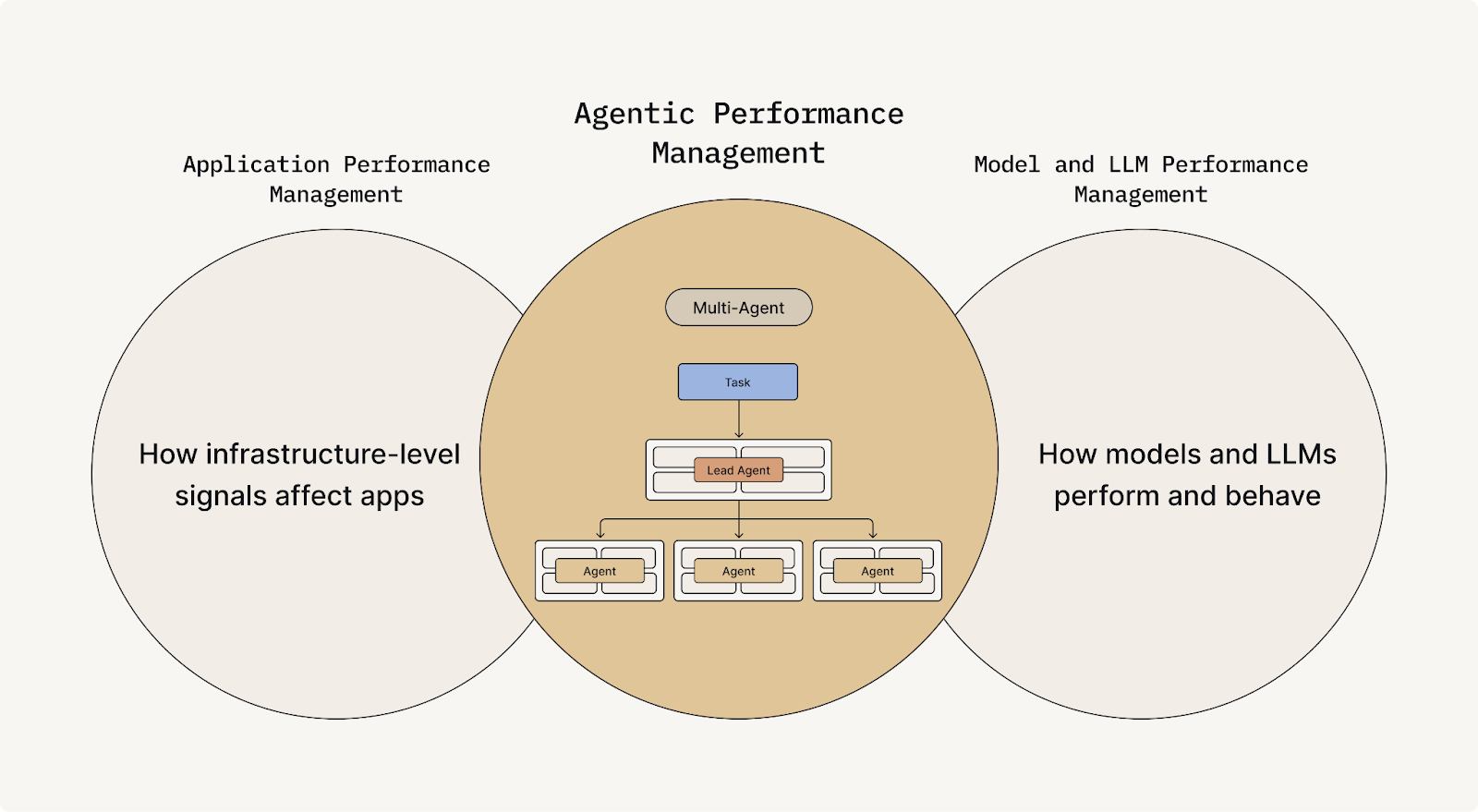Managing Responsible Multi-Agent LLM Systems for Enterprise Applications
Min Read
As organizations rely more on large language models (LLMs), the complexity of their AI applications grows. No longer confined to single-agent systems handling isolated tasks, enterprise AI is entering a new era: multi-agent LLM systems. These systems enable distributed intelligence, decision-making, reasoning, and more adaptable automation.
However, with this increased sophistication comes a significant challenge, such as responsible management. Without the right oversight, multi-agent systems can become opaque, difficult to govern, and prone to unintended consequences. This is where the Fiddler Agentic Observability solution provides essential value. It offers enterprises a comprehensive framework to safely monitor, analyze, and improve multi-agent applications, ensuring they remain effective and responsibly managed.
What is a Multi-Agent LLM System?
A multi-agent LLM system is a setup where multiple AI agents, powered by language models, work collaboratively to complete complex tasks. Unlike single-agent LLM systems, which rely on one model to handle a task end-to-end, multi-agent frameworks divide responsibilities across specialized agents.

Multi-agent systems use multiple LLMs to complete complex tasks in a distributed environment.
This distributed structure is key to managing complex, multi-step workflows. Agents can operate in parallel or sequence, coordinating with each other to solve problems more effectively. Multi-agent systems offer more adaptable and intelligent solutions by leveraging different “perspectives” and skill sets.
For example, a single-agent customer support chatbot might answer general inquiries, but a multi-agent support platform could include:
- A triage agent to classify queries,
- A technical agent for troubleshooting,
- A knowledge agent to retrieve documents,
- A human-in-the-loop escalation agent.
Each plays a distinct role in delivering high-quality service together.
Understanding Agent Systems
At the core of these systems is the agent: a software component that makes decisions, performs tasks, and works with other agents. Each agent is often responsible for a domain or action in multi-agent LLM applications.
These systems range from simple prompt-based agents to more sophisticated constructs using the ReAct (Reason + Act) framework, planning mechanisms, and memory components.
Common agent roles include:
- Planner Agent: Breaks down user input into sub-tasks.
- Tool Agent: Interfaces with APIs or tools.
- Evaluator Agent: Assesses outcomes and provides feedback.
- Orchestrator Agent: Oversees and coordinates all other agents.
This modular structure allows developers to scale applications and adapt quickly to changing business needs.
Multi-Agent Architectures
The architecture of a multi-agent system determines how agents interact, share data, and delegate tasks. The right architecture is critical for ensuring interpretability and scalability.

Agents use advanced reasoning to make autonomous decisions that can impact other agents across sessions, traces, and spans.
Common Multi-Agent Architecture Models:
Understanding how agents interact, delegate, and execute tasks is fundamental to designing scalable and interpretable multi-agent systems. The following architectures define the coordination patterns, task decomposition strategies, and chain-of-action execution used in LLM-based applications:
- Handoff Architecture: Tasks are executed in a linear step-by-step manner, where each agent performs its operation and then passes control to the next. While simple to implement, this model can be fragile. If any agent in the chain fails, the entire process may stall or produce incomplete results.
- Network Architecture: Agents act as peers and communicate dynamically, requesting input or support from others as needed. This model enables high flexibility and parallelism but introduces complexity in managing tool calling, coordination protocols, and message passing across agents.
- Supervisor Architecture: A top-level agent oversees the system and allocates tasks to other agents. It monitors execution, handles exceptions, and intervenes when necessary to maintain performance or correctness. This model supports centralized governance of distributed agent activity while preserving modular task execution.
- Hierarchical Architecture: A lead or orchestrator agent divides complex tasks into subtasks and delegates them to specialized agents. Each subordinate agent may handle a distinct domain (e.g., retrieval, reasoning, or tool calling) and operate within its defined scope. This architecture supports structured multi-step workflows, enhances traceability, and aligns well with agentic observability tools that monitor reasoning chains and agent interactions.
Prevalence of Hierarchical Architectures in Enterprises
Enterprise applications commonly use hierarchical architectures due to their ability to handle complex, distributed tasks. For example, in a travel booking system:
- The Lead Agent manages the overall session and coordinates between agents.
- Sub-agents are responsible for handling flights, hotels, and car rentals.
- Each agent can autonomously access relevant APIs and make decisions based on its area of responsibility.
This structure enhances decision-making quality, monitoring, and traceability by efficiently distributing and managing tasks while aligning with the Fiddler Agentic Observability solution. The platform tracks agent reasoning, tool usage, and coordination patterns, providing valuable insights into the LLM's behavior.
Key Features of Multi-Agent Systems
Several core capabilities define multi-agent systems, enabling them to operate effectively in complex, dynamic environments, especially when building multi-agent systems for diverse use cases:
- Agent Orchestration: Centralized or decentralized management of agents performing sub-tasks and coordinating actions between complex agents.
- Autonomous Decision-Making: Autonomous agents reason independently, based on task goals and real-time context, making decisions without human intervention.
- Collective Intelligence: Multiple agents collaborate to arrive at more accurate, nuanced conclusions, improving system decision-making.
- Role Specialization: Tasks are assigned based on each agent’s strengths or access capabilities, enhancing the system’s flexibility and efficiency when building multi-agent systems.
- Dynamic Adaptability: Agents respond to changes in the environment, user input, or internal state, adapting their behavior for optimal production.
Best Practices for Managing Multi-Agent Systems
Effectively managing multi-agent LLM systems requires a thoughtful combination of governance, observability, and security. The following best practices can help ensure these systems operate reliably and responsibly:
1. Establish Clear Governance Frameworks
- Define roles, responsibilities, and accountability across agents and human stakeholders.
- Create structured escalation paths for human intervention when needed.
- Embed principles of fairness and safety into your system design.
2. Implement Continuous Monitoring
- Leverage real-time observability tools to detect hallucinations, tool failures, or coordination breakdowns.
- Continuously track agent decisions, tool interactions, and handoff flows to ensure operational integrity.
3. Use Robust Observability Platforms
- Observability platforms provide end-to-end visibility, from individual agent reasoning to overall system behavior, helping teams identify and address issues before they affect production.
4. Design for Interpretability
- Build frameworks that support post-task analysis, allowing teams to understand how and why agents make decisions.
- Log inputs, outputs, and reasoning steps to enable effective auditing and debugging.
5. Prioritize Security and Privacy
- Ensure agents that process sensitive information comply with internal policies and external regulations.
- Monitor for vulnerabilities like prompt injection attacks, unauthorized data access, and tool misuse.
Agents in Enterprise Applications
Adopting multi-agent systems is accelerating across enterprise environments, fueled by their flexibility, scalability, and ability to manage complex, dynamic tasks. These intelligent systems streamline operations and enhance decision-making across a variety of high-impact use cases, including:
- Business Process Automation: Agents manage different stages of workflows—such as document processing, CRM updates, and task orchestration—reducing manual effort and increasing operational efficiency.
- Data Analysis and Insights: Specialized agents handle tasks like data cleansing, model execution, and report generation. Each agent focuses on a specific stage of the analytics pipeline, enabling faster and more accurate insights.
- Customer Service: Intelligent agents classify and route complex inquiries to the appropriate team or department based on domain expertise, improving response times and customer satisfaction.
- Disaster Response and Risk Management: Agents collaborate to simulate scenarios, assess possible outcomes, and coordinate real-time mitigation efforts to support faster, data-driven decision-making.
- Cross-Functional Teamwork: Acting as digital collaborators, agents perform specialized tasks and synchronize outputs with enterprise systems such as ERPs or data lakes, enabling seamless integration and improving team productivity.
Why Responsible Management of Multi-Agent System Matters
While multi-agent systems offer significant potential for automation, intelligence, and scalability, they also introduce new risks that require thoughtful oversight. Without responsible management, these systems can quickly become unreliable, non-compliant, or harmful. However, with the proper governance and observability, they become powerful assets that drive long-term value.
Risks of Poor Management
- Compliance Violations: Unmonitored agent behavior can breach data privacy laws and fail to meet compliance standards.
- Security Vulnerabilities: Multi-agent architectures may expose new attack surfaces, making them susceptible to prompt injection, tool misuse, or lateral access risks.
- Operational Failures: Errors made by a single agent can propagate throughout the system, leading to inaccurate results, downtime, or poor user experiences.
Benefits of Responsible Management
- System Reliability: Proactive oversight minimizes failures and improves application stability.
- Scalability: Modular design enables the integration of new agents with minimal disruption or reengineering.
- Stakeholder Confidence: Traceable and interpretable systems build trust across technical, compliance, and executive teams.
- Regulatory Readiness: Strong governance frameworks help enterprises meet evolving AI accountability standards.
- Continuous Improvement: Real-time observability supports iterative enhancements, allowing teams to optimize agent behavior over time.
Leveraging LLM Agent Architecture with Fiddler
Managing multi-agent LLM applications is no longer just a technical challenge. It’s a strategic priority for enterprises looking to scale AI safely and responsibly.
The Fiddler AI Observability and Security Platform equips organizations with the visibility, control, and governance necessary to monitor, analyze, and protect multi-agent systems in production.
Its key capabilities include:
- Real-Time Agentic Observability: Visualize the complete agentic application, tracking agent behavior and multi-agent interactions across sessions to ensure traceability.
- Hierarchical Root-Cause Analysis: Diagnose issues by analyzing prompts, reasoning chains, tool outputs, and decision paths to understand not just what happened but also gain insight into agents’ decisions.
- Guardrails and Alerts: Proactively detect and respond to risks such as hallucinations, safety violations, prompt injections, and coordination breakdowns.
- Cross-Team Collaboration: Facilitate alignment across engineering, product, and compliance teams through a shared, centralized view of agent behavior.

Discover how Fiddler’s Agentic Observability delivers a comprehensive workflow to monitor, analyze, and protect agentic applications. Whether you’re building your first agent system or scaling across departments, Fiddler helps you do it responsibly.
